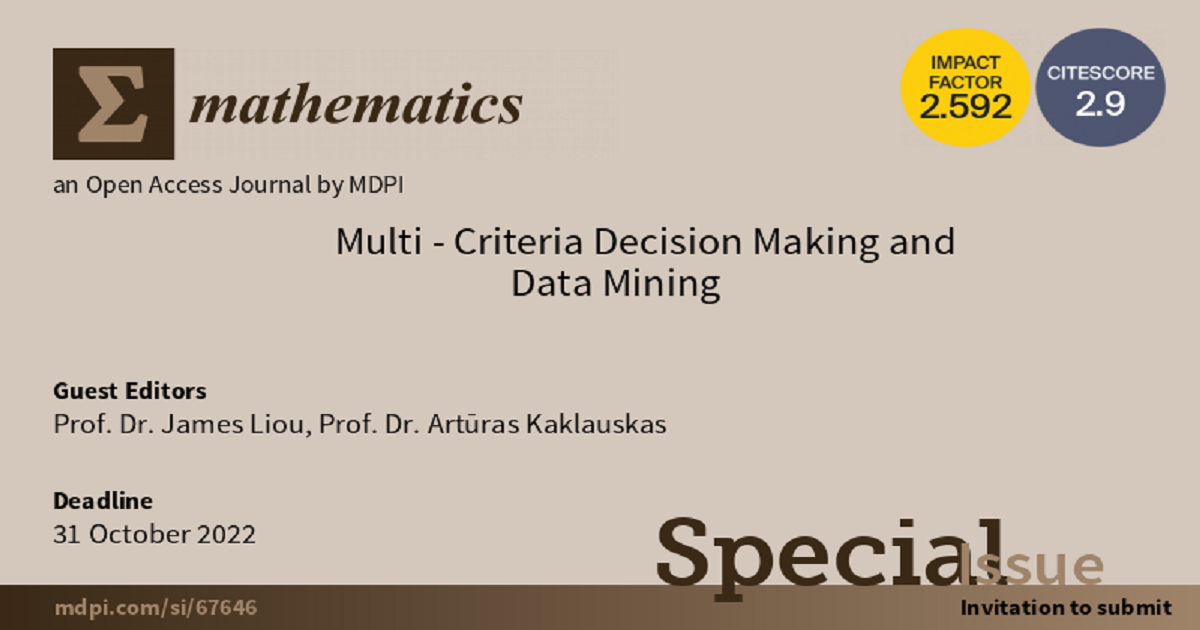Multi-Criteria Decision Making and Data Mining
A special issue of Mathematics (ISSN 2227-7390). This special issue belongs to the section "D2: Operations Research and Fuzzy Decision Making".
Deadline for manuscript submissions: closed (31 October 2022) | Viewed by 127321

Special Issue Editors
Interests: multiple criteria decision making (MCDM); decision support; data mining
Special Issues, Collections and Topics in MDPI journals
Interests: sustainable development; multiple-criteria decision-making; intelligent decision-support systems; environmental, economic, political, and social sustainability dimensions; Industry 4.0; Industry 5.0; Society 5.0; cognitive data mining
Special Issues, Collections and Topics in MDPI journals
Special Issue Information
Dear Colleagues,
With the complexity of the socioeconomic environment, decision making is one of the most notable ventures, whose mission is to decide the best alternative under numerous qualitative and quantitative factors/criteria. Multiple-criteria decision-making (MCDM) methods and hybrid models are quickly emerging as useful methods for evaluating and improving alternatives. Through the gradual maturation of information technology and growth of the data analysis environment comes the accumulation of large amounts of data within organizations. Therefore, some data-driven MADM models which integrate machine learning/data mining and MCDM methods to help decision-makers select the best alternative in various industries have been developed. Data mining or machine learning techniques are primarily concerned with discovering hidden patterns and relationships in data to assist decision-makers making judgements. MCDM is mainly concerned with problems which require ranking, classification, and sorting based on multiple criteria or attributes. Combining data mining with MCDM methodologies to establish new or hybrid decision-making models can combine the advantages of both methods in management sciences.
This Special Issue aims to collate original research papers that offer the latest developments and applications of MCDM, data mining or hybrid models in the broad fields.
Prof. Dr. James Liou
Prof. Dr. Artūras Kaklauskas
Guest Editors
Manuscript Submission Information
Manuscripts should be submitted online at www.mdpi.com by registering and logging in to this website. Once you are registered, click here to go to the submission form. Manuscripts can be submitted until the deadline. All submissions that pass pre-check are peer-reviewed. Accepted papers will be published continuously in the journal (as soon as accepted) and will be listed together on the special issue website. Research articles, review articles as well as short communications are invited. For planned papers, a title and short abstract (about 250 words) can be sent to the Editorial Office for assessment.
Submitted manuscripts should not have been published previously, nor be under consideration for publication elsewhere (except conference proceedings papers). All manuscripts are thoroughly refereed through a single-blind peer-review process. A guide for authors and other relevant information for submission of manuscripts is available on the Instructions for Authors page. Mathematics is an international peer-reviewed open access semimonthly journal published by MDPI.
Please visit the Instructions for Authors page before submitting a manuscript. The Article Processing Charge (APC) for publication in this open access journal is 2600 CHF (Swiss Francs). Submitted papers should be well formatted and use good English. Authors may use MDPI's English editing service prior to publication or during author revisions.
Keywords
- Multiple-criteria decision-making (MCDM)
- Data mining
- Data driven
- Machine learning
- Knowledge-based systems
- Hybrid multiple-criteria decision-making methods
- Intelligent decision support systems
- Optimization techniques
- Soft computing
- Application of MCDM methods
- Site selection
- Resource allocation
- Supply chain management
- Production management
- Quality management
- Risk management
- Decision analysis for sustainable production and consumption
- Group decision making
- MCDM theories
- MCDM in strategic management
- Decision making
- Hybrid decision-making analysis
- Information technologies in decision making
- Innovative applications of MCDM methods
- Weighting approach
- Technologies and techniques
- Sustainability assessment data mining models and tools
- Data mining result validation
- Privacy concerns and ethics
- Practical applications (government, international development, culture healthcare, education, media, insurance, Internet of Things, agriculture, industry)
- Case studies
- Impacts of data science
- Quality of city life and data mining
- Smart city and data mining
- Behavioral change and data mining
- Neuromarketing and data mining
Benefits of Publishing in a Special Issue
- Ease of navigation: Grouping papers by topic helps scholars navigate broad scope journals more efficiently.
- Greater discoverability: Special Issues support the reach and impact of scientific research. Articles in Special Issues are more discoverable and cited more frequently.
- Expansion of research network: Special Issues facilitate connections among authors, fostering scientific collaborations.
- External promotion: Articles in Special Issues are often promoted through the journal's social media, increasing their visibility.
- Reprint: MDPI Books provides the opportunity to republish successful Special Issues in book format, both online and in print.
Further information on MDPI's Special Issue policies can be found here.






